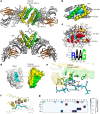Targeting peptide antigens using a multiallelic MHC I-binding system
- PMID: 39672954
- PMCID: PMC12163099
- DOI: 10.1038/s41587-024-02505-8
Targeting peptide antigens using a multiallelic MHC I-binding system
Abstract
Identifying highly specific T cell receptors (TCRs) or antibodies against epitopic peptides presented by class I major histocompatibility complex (MHC I) proteins remains a bottleneck in the development of targeted therapeutics. Here, we introduce targeted recognition of antigen-MHC complex reporter for MHC I (TRACeR-I), a generalizable platform for targeting peptides on polymorphic HLA-A*, HLA-B* and HLA-C* allotypes while overcoming the cross-reactivity challenges of TCRs. Our TRACeR-MHC I co-crystal structure reveals a unique antigen recognition mechanism, with TRACeR forming extensive contacts across the entire peptide length to confer single-residue specificity at the accessible positions. We demonstrate rapid screening of TRACeR-I against a panel of disease-relevant HLAs with peptides derived from human viruses (human immunodeficiency virus, Epstein-Barr virus and severe acute respiratory syndrome coronavirus 2), and oncoproteins (Kirsten rat sarcoma virus, paired-like homeobox 2b and New York esophageal squamous cell carcinoma 1). TRACeR-based bispecific T cell engagers and chimeric antigen receptor T cells exhibit on-target killing of tumor cells with high efficacy in the low nanomolar range. Our platform empowers the development of broadly applicable MHC I-targeting molecules for research, diagnostic and therapeutic applications.
© 2024. The Author(s).
Conflict of interest statement
Competing interests: H.D., N.G.S. and P.-S.H. are listed as coinventors on provisional patent applications related to this work. The remaining authors declare no competing interests.
Figures




References
-
- Schumacher, T. N. & Schreiber, R. D. Neoantigens in cancer immunotherapy. Science348, 69–74 (2015). - PubMed
MeSH terms
Substances
Grants and funding
- 75N93022D00005/AI/NIAID NIH HHS/United States
- R35 GM125034/GM/NIGMS NIH HHS/United States
- ACS134055-IRG-218/American Cancer Society (American Cancer Society, Inc.)
- 75N93023D00005/AI/NIAID NIH HHS/United States
- 75N95020D00005/DA/NIDA NIH HHS/United States
- 75N99020D00005/OF/ORFDO NIH HHS/United States
- P30 GM133893/GM/NIGMS NIH HHS/United States
- 75N92020D00005/HL/NHLBI NIH HHS/United States
- T32 GM141819/GM/NIGMS NIH HHS/United States
- U01 DK112217/DK/NIDDK NIH HHS/United States
- T32GM141819/U.S. Department of Health & Human Services | National Institutes of Health (NIH)
- R01 AI143997/AI/NIAID NIH HHS/United States
LinkOut - more resources
Full Text Sources
Molecular Biology Databases
Research Materials

